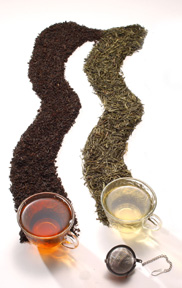Another Green That Might Prevent Breast Cancer
Many studies have indicated that diets high in produce–including broccoli and other veggies–may lower a woman’s risk of developing breast cancer. Now, California researchers report data suggesting that drinking green tea does the same thing. Bad news for women who–like me–prefer black tea: The study failed to identify a similar advantage from such brews, much less coffee or herbal “teas” such as chamomile and African rooibos.


The new data aren’t the first to link green teas to anticancer benefits. Dozens of animal and test-tube studies have highlighted the potential of those brews to fight malignancies in mammary and other tissues. For instance, researchers at the University of California, Los Angeles and the University of Texas in Houston showed last year that an extract of green tea inhibits breast cancer cells from making a chemical that supports tumors. The chemical, a growth factor, fosters new blood vessels that nourish the cancer. The study’s results help explain why previous work by the group showed that green tea extract suppresses the growth of breast tumors in animals.
What sets the new study apart, however, is that it’s the first confirmation of green tea’s power against breast cancer in people. It also dovetails with several other studies in women showing no breast-cancer protection from even heavy black-tea consumption.
Globally, tea ranks second only to water as the preferred liquid refreshment. Though green tea remains popular in Asia–and accounts for roughly 23 percent of all teas drunk–it’s largely ignored in the West, where black tea reigns.
In fact, both brews come from the same source–leaves of Camellia sinensis. For green teas, producers steam or otherwise heat fresh leaves shortly after harvesting, before fermentation reactions begin transforming the plant’s natural polyphenols. These are compounds in tea and many other plants that serve as natural antioxidants.
To make black teas, manufacturers first crush and dry the leaves, which fosters oxidation of polyphenols and a darkening of the leaves. The process converts tea leaves’ simple polyphenols–such as catechins and gallocatechins–into complex polyphenols, such as theaflavins.
For the latest study, Anna H. Wu of the University of Southern California in Los Angeles and her colleagues recorded diet and other facets of lifestyle in 501 women with breast cancer and 594 cancerfree women from the same Los Angeles neighborhoods. All were Asian Americans of Chinese, Japanese, or Filipino descent, ages 25 through 74.
Cancer patients and healthy women were comparable in their education, nation of birth, age of puberty, and height and weight. However, there were a few notable differences in the two groups. The cancer patients tended to have fewer children, to eat less soy, and to exercise less. But what really set the two groups apart was that women in the healthy group were far more likely to drink green tea.
Overall, the researchers found, drinking an average of up to 85 milliliters (ml) of green tea per day–that’s less than 6 tablespoons–appeared to cut a woman’s breast cancer risk by almost 30 percent, compared with women drinking no green tea. Green tea drinking halved her risk if she typically drank more green tea.
Focus on tea
During face-to-face interviews, Wu’s team questioned each volunteer on her family history, reproductive history, menstrual history, and diet. Each woman was shown measuring cups and asked to quantify the amount of various coffees and teas she had been drinking.
Overall, the Chinese-American participants consumed about three times as much black tea per day (180 ml) as the Japanese-American or Filipino-American women did. Except for the Japanese Americans, women born overseas drank more black tea than did women born in the United States, Wu’s team reports in the Sept. 10 International Journal of Cancer.
Green tea consumption was highest among the Japanese Americans (160 ml per day). They downed, on average, 60 percent more than the Chinese Americans did and more than six times as much as did the women of Filipino descent. However, for each group, foreign-born women drank on average at least twice as much green tea as did women in their ethnic group who were born in the United States.
More importantly, Wu’s team found, the cancer patients were more likely to eschew tea than were the healthy women. Among cancer patients who drank tea, a smaller share drank green tea; and those who did drink green tea tended to consume smaller quantities than the healthy women drank.
Wu and her coworkers acknowledge that many factors could have influenced the women’s risk of breast cancer. For instance, it could be that green tea drinkers have fewer unhealthy habits such as smoking tobacco and drinking alcohol. However, the researchers probed for such confounding factors and found that green tea’s apparent benefit persisted no matter how much a woman smoked or drank. Other factors that the researchers found didn’t erase the green tea’s effect were a woman’s consumption of red meat, processed meats, poultry, milk, coffee, or fish; how much she exercised; and whether she had a history of breast cancer in her family.
Moreover, the researchers observe, “green tea drinkers showed a significantly reduced risk of breast cancer compared to non–green tea drinkers, even after adjusting for age, Asian ethnicity, birthplace, age at menarche” and a host of other potential risk factors, such as calorie intake, menopausal status, use of menopausal hormones, calorie intake, body size, or number of past pregnancies.
What about soy?
Researchers have puzzled for decades over why women in Asia tend to have dramatically lower breast cancer rates than do U.S. women, including those who migrated from Asia. For a long time, the leading suspicion has centered on the greater intake of tofu, tempeh, and other soybean products in East Asia than in this country.
Because Wu’s study had been designed in part to investigate this question, she and her colleagues surveyed their volunteers’ soy consumption as children and adults. The researchers turned up what they describe as “an intriguing interrelationship between intake of green tea and soy that points to the possibility of a shared anticarcinogenic mechanism.” A significant protective effect of soy products showed up only in women who didn’t drink green tea–and vice versa.
In other words, either green tea or soy seemed to provide a benefit that wasn’t increased by addition of the other. If one looks at the chemical profiles of the two foods, Wu’s team notes, both green tea and soy products have an abundance of powerful antioxidants. Since the chemicals called free radicals have been implicated in several cancers, the quashing of free radicals by antioxidants might offer one explanation for these foods’ anticancer effects.
The chemical interaction might also explain why a previous study in Japan found no benefit from green tea against breast cancer. Wu notes that both groups were probably consuming a typical Asian diet that was rich in soy and therefore protective against breast cancer.







